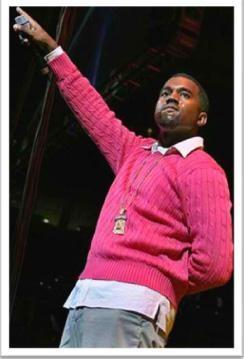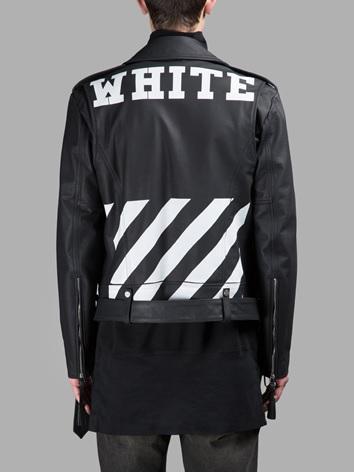In the past couple years, pieces from high fashion have found their way into streetwear and the line has began blur between high fashion and streetwear as two separate styles. It is no secret that hip hop music has had heavy influence in this. Of course, streetwear as a style was initially popularized by rappers. Jordan’s, NBA jerseys, flat brim hats, and baggy clothes were what it started out as in its early stages. In the mid 90’s, brands like Supreme and Bape emerged and would lead the era of streetwear brands, designed with the sole purpose of being streetwear clothing, being the overwhelmingly popular option for dressing in a streetstyle. Loud, flashy designs with the brand’s logo plastered across the clothing were what defined the style. Around 2003, however, Kanye West emerged on the scene. He not only brought a new sound in his music, he wore a pink polo and Louis Vuitton backpack in the public eye as a rapper.

Kanye in the early 2000’s, wearing his trademark pink polo
This was unprecedented, as everyone expected rappers to be tough and street, not to wear something as flamboyant as a pink polo. He achieved major success after this and was the first to send the message that not all rappers had to be macho tough guys, setting up the collision of high fashion and hip hop. Unsurprisingly, Kanye nowadays heavily involves himself with high fashion and following in his steps, many other rappers do as well. Name drops of luxury brands such as Givenchy, Rick Owens, Raf Simons, Balmain, Balenciaga, and even newer brands such as Damir Doma have become commonplace. Despite the fact runway fashion has trickled down to the street level, streetwear has never found its way to the runway. It makes sense too; it is hard to picture elegant flowing dresses, menacing leather outerwear, and delicately patterned shirts next to the blatant branding of a Supreme box logo hoodie. Streetwear simply had no place in its current state on the runway. Enter Virgil Abloh.
Virgil

Virgil and Kanye attending a Paris Fashion Week show
The 34 year old former architect and Chicago native is Kanye’s creative director and has been since 2002. And, like Kanye, is a fan of both hip hop and high end fashion. He has been seen wearing high end pieces and attending fashion shows, his interest in runway is more than apparent. It would make sense that being surrounded by all this creative influence, Virgil would want to design clothes. Thus, he founded Pyrex Vision.
Pyrex was, by Virgil’s own description, an art project where he intended to only work with a single graphic. The Pyrex graphic was simply the word “PYREX” in blocky white letters. The graphic was put across the front of blank athletic shorts from the sportswear company Champions, and the shorts were sold for $60.
The quality was on par with all the regular shorts from Champions, which retail for around $15. While many people bought the shorts for the hype behind the graphic, many others (possibly the same people buying the shorts) ranted that it was a ripoff to pay four times the price of normal shorts for a word written across the crotch. The same complaints of been made about all streetwear companies, notably Supreme who’s famous box logo hoodie retails $138. Despite complaints, every time Supreme drops the famous hoodie (once a year), it sells out within literal seconds and often sells on the secondhand market for double or triple the retail price. The same was happening for Pyrex, the shorts sold out with rapidity and were selling for exponentially increased prices on the secondhand market. Perhaps Virgil noticed he wasn’t really creating fashion and was simply marketing hype, or he was bored of the limitations of the Pyrex graphic. Either way, a few years later in 2012, Virgil Abloh founded Off-White ℅ Virgil Abloh.
Off-White ℅ Virgil Abloh

Virgil stated from the start of Off-White that he wished to bridge the gap between high fashion and streetwear. The iconic graphic for Off-White was an image of horizontal hazard stripes and the word “WHITE” in all capital letters. It seemed impossible that the man who had been selling Champions shorts for four times the price to the streetwear and hypebeast crowd would be able to create anything worthy of being deemed “fashion”, let alone make it to the runway while seeming to stick to the same hypebeast-fueled ideas.
Virgil set out to prove his doubters wrong three years ago, and since then has had three seasons of collections shown during various fashion weeks. How did he manage to create a far more serious image of a creator of content for himself after being known as “Mr. Pyrex Shorts” and “Kanye’s dude” for so many years?
The first thing, though it seems superficial and irrelevant, was the pricing. Pyrex hoodies retailed for around $200 and shorts for of course $60. The same kids who were buying Supreme and wearing Nikes were able to buy Pyrex, assuming they bought it before it sold out. The brand Pyrex became associated with the idea of an hype-driven teenager dressed in the latest Jordan release, a Supreme box logo hoodie, a five-panel hat, and Pyrex shorts to complete the look. This was a look considered juvenile and frankly, bad, by anyone involved in the high fashion industry and any active consumer of high end clothes. To create a new image for himself, Virgil needed to do something to that would seem counterintuitive to any business-minded person; he needed to make his product inaccessible to his core demographic, hoping a higher income demographic with more refined taste would take him in. Off-White retails at high end boutiques alongside other designers. Websites such as SSENSE, Antonioli, and Luisa Via Roma carry Off-White, as does high-end department store Barney’s New York. So far, Virgil’s image revamping plan has worked – sort of. While many high end consumers have embraced Off-White and wore it with other designer pieces as Virgil had hoped, others called it tacky and overpriced, seeing it as Pyrex 2.0. Off-White’s critics claim that just like Pyrex, Off-White’s only unique feature is it’s easily recognized graphic, meaning it was still simply overpriced streetwear.
While Off-White does moderately revolve around a single graphic (hazard stripes accompanied by the word “WHITE”), it has managed to free itself from the graphic being the sole reason pieces sold. Unique touches (subtle patterns, patchwork, distressing) as well as higher quality materials (100% wool, high-grade cotton, heavyweight denim) give worth to pieces outside of hype for a logo. And while the relatively heavy use of the graphic is unlike other brands of similar price, it keeps the brand true to its streetwear roots and is part of the reason Off-White is able to bridge the gap between the high end world and the street, not only exist in one or the other.
In fact, in Off-White fashion week collections, the logo is hardly present. Save for a few hints and nods, the focus during collections is the proportions of the silhouettes and the tailoring of the garments. In the latest Off-White S/S 2016 collection, the focus was on playing with proportions in typical workwear, with the collection fittingly named “Blue Collar”.

The collection was based around the colors black and blue and featured very loose-fitting pieces, wide and billowing. The intentionally ill-fitting garments, as well as wide and thick-soled sandals, had models appearing small in their clothing, like a boy in his father’s suit. Denim workshirts, dirty ponchos, and rain ponchos helped show the grittiness of the working class models and the avant-garde tailoring paired with asymmetrical detailing and distressing kept the show interesting. In the midst of all this, the word “WHITE” still peeked out here and there, a patch of hazard stripe every now and then, demonstrating faith to his streetwear roots. The show received positive reception and positively surprised those who expected a generic Pyrex 2.0 logo plastered mess – of which included me.
Viewing “Blue Collar” amidst flipping through a week of collections drew me into the world of Off-White and made me excited to see what Virgil and his team have in store for the future to blur the lines between the runway and the street even further.
